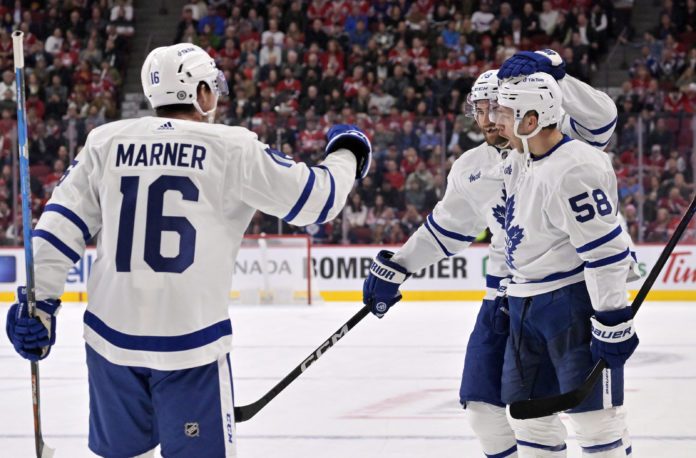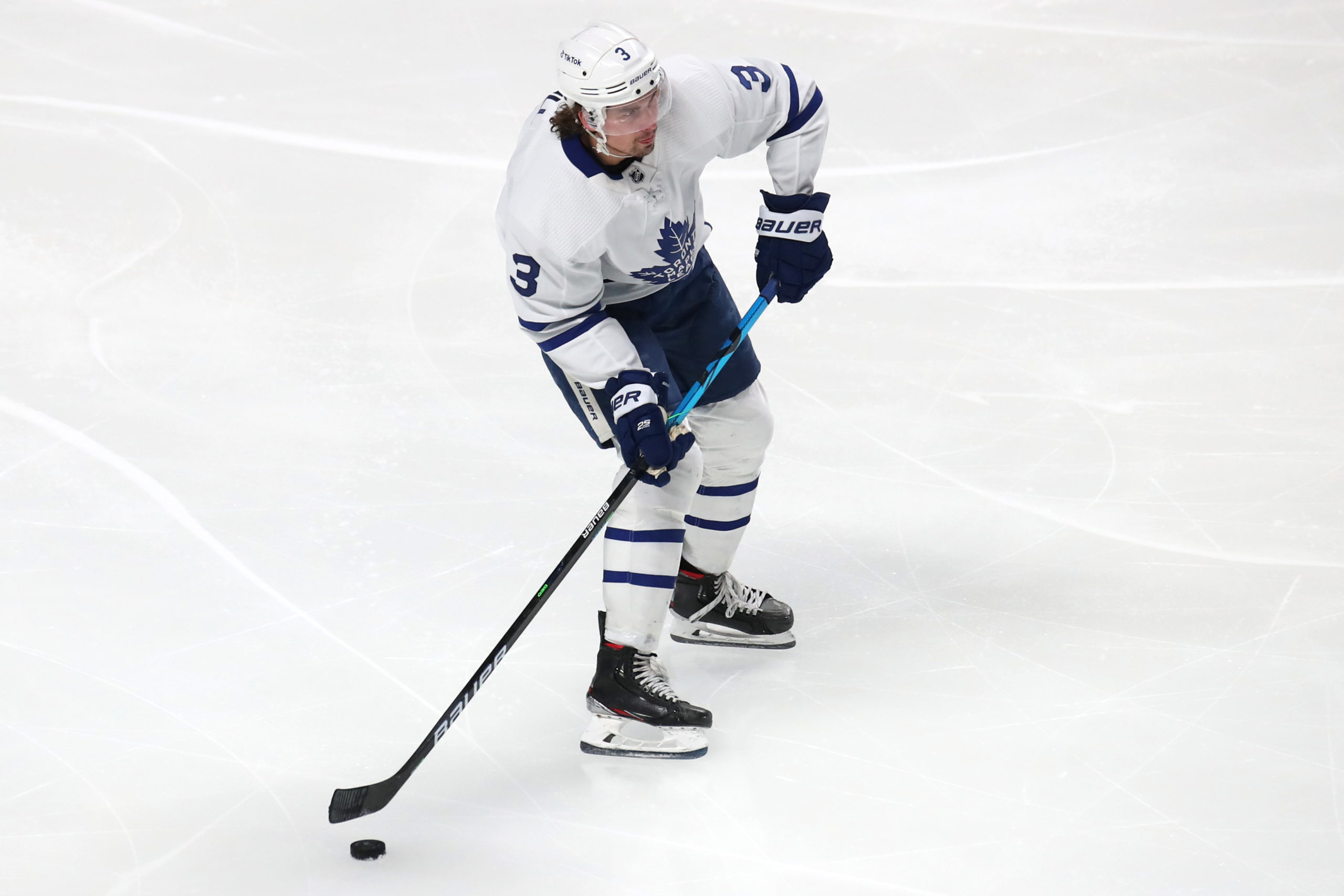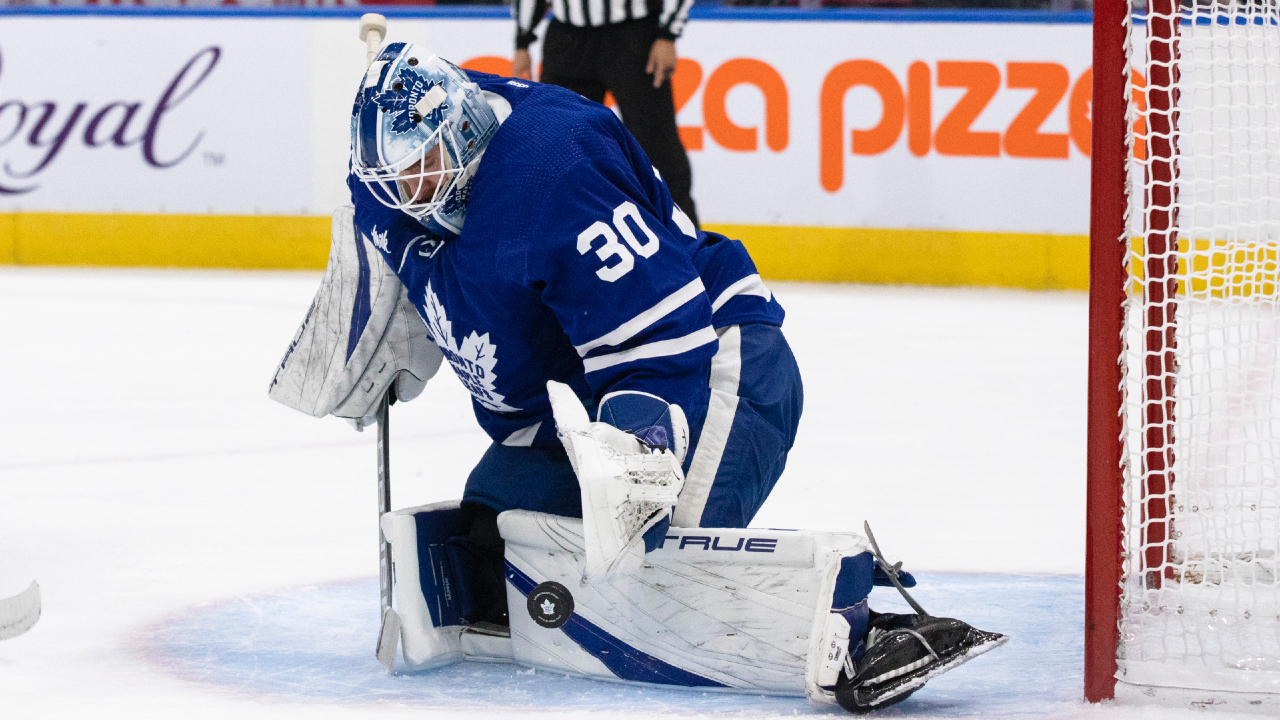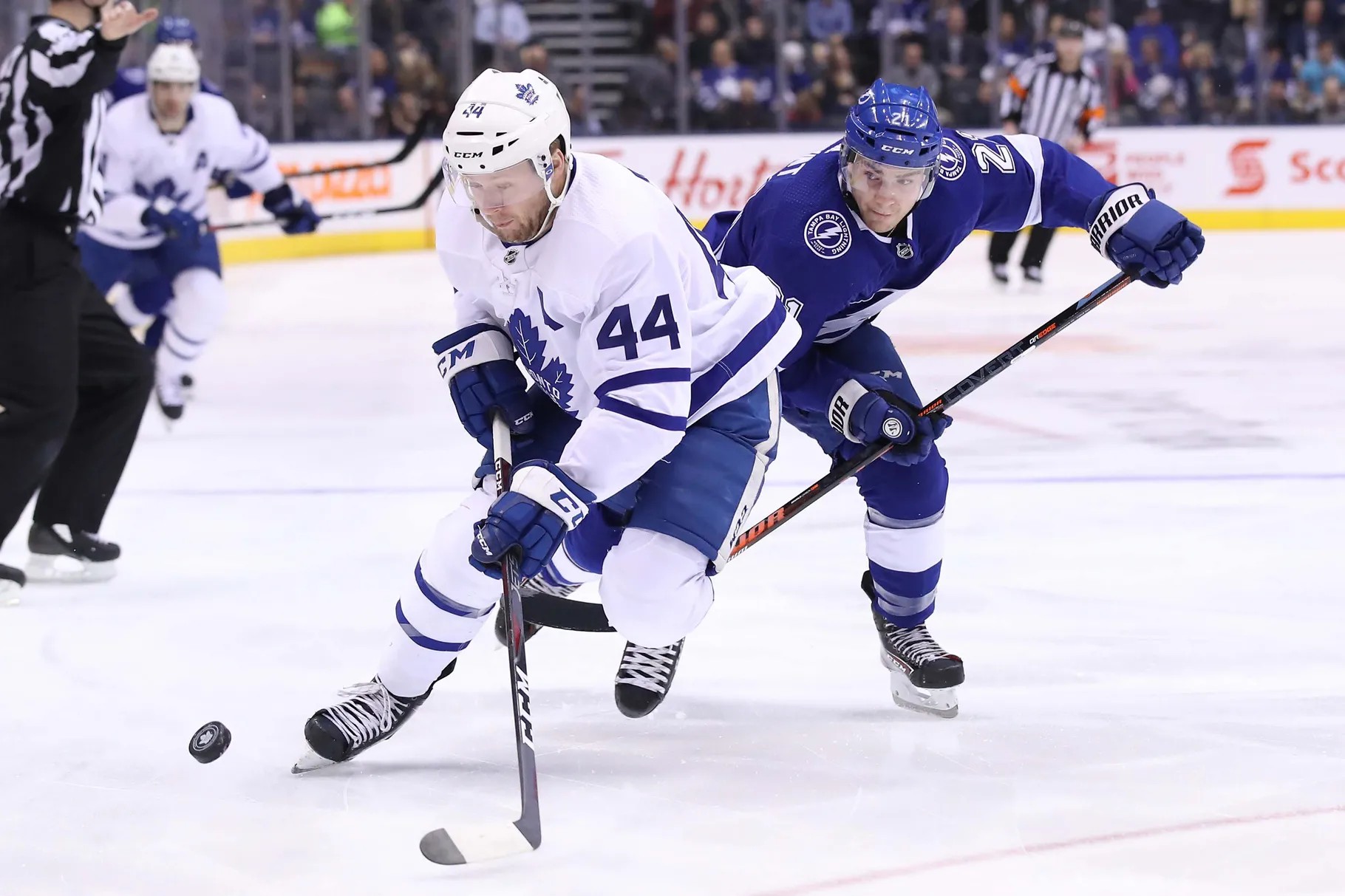
Through three games this season, Auston Matthews has played over 20 minutes only once.
It was only a few seasons ago – in the shortened 2020-21 season – that Matthews only played under 20 minutes in just 12 of 56 games, half of which came in the final eight games of the season with the division already wrapped up and nothing left to play for in the standings.
The ice time of Matthews and Mitch Marner, in particular, became a hot-button topic while Mike Babcock was coach, with the debate centering around whether the pair was playing enough. When Sheldon Keefe took over the bench, he arguably overcorrected for it.
Marner led all forwards in time on ice per game in the 2020-21 season and Matthews was fifth. In the playoffs, the pair struggled and played worse as the series wore on; at times, they looked visibly out of gas late in games. In Game 7, the Leafs barely mustered a push in the third period when trailing (that said, there is also the argument that they were mentally crumbling under the pressure of the moment as opposed to physically wearing out from playing too many minutes).
Last season, their ice time was reduced. Matthews was down around a minute from the season before and Marner was down nearly a minute and a half. They averaged 20:37 and 20:53, respectively, last season. So far this season, the pair is sitting at 19:47 and 20:44, but I would imagine those numbers will even out over time and probably land closer to their minutes from last season.
Granted, it’s early and Keefe has generally kept all 12 of his regular forwards in the double-digit range (except for Wayne Simmonds last season), but many of those numbers were somewhat deceiving. Down the stretch and into the postseason, their older depth players were playing less – Jason Spezza and Colin Blackwell averaged nine minutes each in the playoffs last season, Joe Thornton saw his ice time dwindle against the Habs, and they used players like Riley Nash and Adam Brooks in limited minutes.
This season, the Leafs don’t have any over-the-hill veterans or extremely limited players among their top 12. It’s something Keefe was touting throughout camp, explicitly noting:
To me, this is the most depth and options I have had coming into a camp in terms of what it might look like. I am excited to see that play out. I like what we have available to us.
We have seen this dynamic play out so far.
Last season, Matthews averaged 17:27 per game at even strength, which was fifth among all forwards in the league. So far through three games, he’s at 15:51. John Tavares is down two minutes in even strength time on ice so far, while William Nylander is down nearly a minute.
Where I suspect we might see a small difference from last season: limiting the number of big-minute games after Matthews and Marner each played 23+ minutes in 15 games last season.
The other consideration might be preserving John Tavares. He’s playing only 16:21 so far and has looked re-energized. He has never averaged under 18 minutes per game in his entire career. The Leafs captain is 32 now with a lot of mileage on him, and they appear to be trying to keep him fresh.
We’ll see if it lasts, but with a fourth line anchored by David Kampf, it’s the first time Keefe has had a fourth line at his disposal that he can actually trust against top competition. It’s a no-thrills line, but it has value in most games unless the Leafs go down big early. Their fourth-line players aren’t at an age where he has to manage their workload, either.
The other two lines can obviously score and will naturally get their minutes.
At most, this is a subtle change, but the Leafs are at a point where it’s about the subtle tweaks on the margins adding up to make a difference. Preserving the stars throughout the season as best as possible is one of them.
Notes

– The Leafs have five goalies under contract, which is fairly common across the league. Three goalies getting hurt at the same time is not (thankfully, Erik Kallgren‘s injury wasn’t serious). Criticism towards management for a number of injuries happening at the same time is a little unfair. A legitimate criticism, though, is the team sitting up against the 50-contract limit. Only one other team in the league is maxed out at 50 contracts – and that’s Vegas, who has put on a masterclass of mismanagement over the past 18 months or so.
– A small change I’ve noticed a bit more on the Leafs penalty kill: In the neutral zone, they are stacking up both forwards and a defenseman in front of the blue line with a defenseman hanging behind them as insurance in a 3 – 1 formation. Usually, teams run a 1 – 3 with a forward applying pressure while the other three penalty killers form a wall just inside the blue line. They then try to angle the other team to create turnovers.
This hasn’t been a consistent approach by the Leafs, but it’s an interesting wrinkle to try to force more dump-ins.
– It was a tough first game followed by two really good ones for Justin Holl. Of course, the late game-winner on Saturday grabbed the headlines, but he made big plays on defense, too. He was on to close the game in the final minute against Ottawa after scoring, and the Senators failed to create much of anything. Against Washington, he was the one blocking Alex Ovechkin shots on the penalty kill at the end and he effectively iced the game when he stepped up on John Carlson, who was in the one-timer spot trying to put a puck to the net in the dying seconds.
Holl is not a stud back there, but he takes way too much flak in this market. He leads the team in shorthanded time on ice per game and is a legitimately good penalty killer. He’s third among defensemen in time on ice per game and handles tough matchups night in and night out. It’s a thankless job (clearly), but he does it well.
– Even though Alex Kerfoot is playing center, he has taken only 12 even-strength faceoffs, the least among the Leafs centers. His linemate, Calle Jarnkrok, has taken eight. Kerfoot has generally hovered as a low-40s faceoff player. He’s under 43 percent so far while Jarnkrok is at 50 percent.
– The Leafs, after owning the third-best home record in the league last season, are already at 2-0-0 through three games of 2022-23. It seems like it has flown under the radar amid all the Leafs’ regular-season success, but Toronto has once again become a very difficult place for opponents to play.
– I haven’t written about this much, but now that the season is underway, I have to say: I miss LeafsTV. I think it was a big mistake to get rid of it. The solution is not to cancel the program altogether and move more to digital platforms (whatever that means). Leafs games in an hour were a staple. The old Leafs game replays they used to air were also awesome.
At times over the years, LeafsTV did have good programming. So many media members got their start there. In a city like this with a team as big as the Leafs, they should be able to make it work. Instead of asking the question, “How can we make this a great program for Leafs fans,” they canceled it and seem to believe their digital shift will be worth it.
Quotes

“Matt unfortunately in his time here, was injured all the time. Take nothing away from him. He was just hurt all the time.”
– DJ Smith on Matt Murray’s time in Ottawa
The Matt Murray acquisition was always risky for two equally important reasons: 1) Is he any good anymore after struggling for the last three seasons; 2) Can he stay healthy?
In the first week, the Leafs got a taste of both concerns. Now, he’s going to have to battle back from injury and attempt to work his way into the team during the season.
Obviously, the Senators organization was frustrated with this recurring theme. This isn’t to say it’s impossible for Murray to return in a month or so and establish himself this season, but it’s tough. Last season, Petr Mrazek didn’t look too bad at the start, but he went down injured, and when he returned, it was a tough path back for him. On a new team in a new season, starting with an injury is a tough hill to climb.
“With everything our team has been through together, that is unacceptable. We have to be way more responsible.”
– Sheldon Keefe after an opening night loss to Montreal
I was kind of surprised Sheldon Keefe called the team out right off the bat after game one, but at the same time, I understand where he is coming from. They returned the core – again – and they largely kept the same line combinations intact, and that was how the team started the season.
“Everyone is always excited to try and show out against us and prove a point.”
– Mitch Marner on teams getting up to play the Leafs
It is always like this in Toronto, and it’s especially the case when the Leafs are really good. I suspect that’s partly why the Leafs struggled against weaker teams last season. They got up for the games, and the Leafs didn’t match it.
Tweets of the Week

Justin Holl has 10 career goals and three of them are game-winners against the Ottawa Senators
— Michael (@TheLeafsIMO) October 16, 2022
A hilariously fun stat.
I only RT this 2021 tweet because Caufield's 2nd reminded me of it exactly – Rielly (who I liked last night) can trust his teammates and put more pressure on the shooter on these rushes. Want the save in both cases, of course, but he allows shooters to get off forceful shots. https://t.co/pQXQ5igwkQ pic.twitter.com/lRYVdYUWbR
— Justin Bourne (@jtbourne) October 13, 2022
Morgan Rielly has almost always struggled with gap control. He’s a much more confident skater going forwards than backwards, and it shows. This play involved a bit of a miscommunication against the Habs, but sometimes you have to tip your hat for a good play, too. Josh Anderson played it well to drive the net hard, which made it look worse.
We pretty well know what Rielly is at this point, and it’s not going to change: He’s great offensively, limited defensively, and he can play a ton of minutes thanks to his overall skating ability. But it is noteworthy that he has been on the ice for six goals against so far this season.
Watch William Nylander on this shift.
Breakaway..
Slick exit leads to his own rush chance via give-and-go..
Defensive play, flip out leads to Kampf tying goal.
Doesn't get a point, doesn't even get + but heck of a shift. pic.twitter.com/vfee1L68FW— Mike Kelly (@MikeKellyNHL) October 16, 2022
That is one heck of a shift from William Nylander, who has started the season strong. I also really liked seeing Nylander out there with Auston Matthews and John Tavares (it’s often Marner that we see out there with Matthews and Tavares, if anyone).
Five Things I Think I’d Do

1. Now that the Leafs have called up Nick Robertson, I think they have to play him. Using the LTIR relief to call him up just to have him eat popcorn in the press box is a waste of everyone’s time and isn’t helping him develop. Last season, they called him up and gave him limited fourth-line minutes at times.
They only play three games this week (Monday, Thursday, and Saturday) coming off of three games in four nights to start. I’d give Roberston the Arizona game right away over Denis Malgin, who is not exactly running away with the opportunity he has been given (albeit it’s only three games).
That doesn’t mean he has to play in the top six necessarily. They could easily put Calle Jarnkrok on the second line and Robertson with Alex Kerfoot and Pierre Engvall. That would be a good option as well to go along with second unit power-play time.
2. Similarly, I’d probably give Wayne Simmonds one of the games. I am not sure which one yet – and it would be more of a, “let’s give this roster player a rest” type of game – but they are obviously trying to trade him, so giving teams a look isn’t a bad thing. It could be a last-hurrah type of move, which he has earned over his career.
3. I know the coaching staff won’t do this, but I’d really make an effort to try out Michael Bunting with other linemates, especially as the Leafs consider paying him on a new deal (potentially long-term). The Leafs tried to keep Zach Hyman’s AAV at a certain amount over a max term, but Hyman had established the ability to drive a line all on his own (he is also a strong penalty killer and net-front guy).
Bunting has shown he can play alongside top players well. Can he carry a line? How effective is he without two elite players beside him? On special teams, he is – at best on this team – a secondary power-play guy. How much should the Leafs realistically pay for that type of player?
For what it’s worth, I think there are a ton of players who can successfully play alongside Auston Matthews and Mitch Marner. They are probably two of the easiest players in the league to play with when we consider their obvious skill, their willingness to play defense, how they move the puck, and that one of them is the best goal scorer in the league.
The Leafs went through this process once already and found Bunting to slot in beside their star duo on the cheap. They can surely do it again.
4. As an overall approach, I think I’d be looking to mix and match the defense pairings as much as possible for the first half of the season versus setting it and giving it time to gel. This group already knows how to play with specific partners; we’ve already seen the current pairs matched together plenty. They’d benefit from finding out what else they can discover through swapping around the pairings.
How would Morgan Rielly – Justin Holl hold up? Could Mark Giordano pair up with Jake Muzzin and help him settle his game down a bit? What about TJ Brodie back on the right to allow Rasmus Sandin to play on the left more?
There are all sorts of combinations to ponder. I’d use this time to experiment and evaluate. There’s no real right or wrong answer as to who plays with who. They have six good NHL defensemen.
5. Over the next 10 games, the Leafs only have one back-to-back (they have another coming up almost right after in early November). I think I’d run with Ilya Samsonov as much as possible and give him a real opportunity to seize the net. He has been solid if unspectacular so far through two games. These are similar circumstances to when Jack Campbell grabbed the net in Frederik Andersen’s absence.
Even if Erik Kallgren were to come in and play lights out, once Murray returns, it will be Murray – Samsonov on the team. The potential upside here lies in Samsonov running with it. If he keeps playing as he has so far, that’s more than enough to keep feeding him starts. I’d give him eight of the 10 games coming up.
































